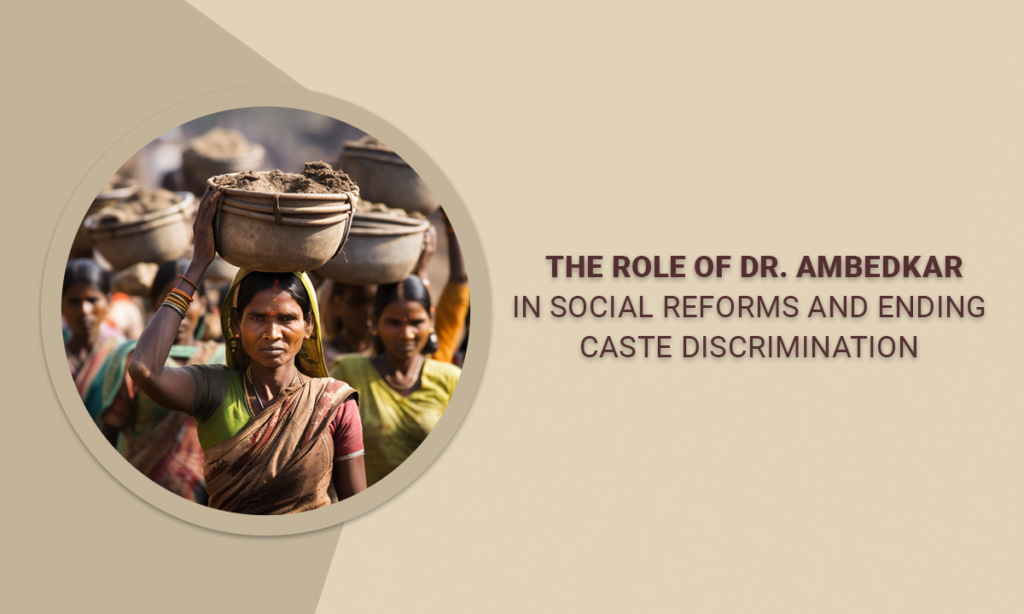Introduction
Dr. Bhimrao Ramji Ambedkar, often fondly referred to as Babasaheb, was a visionary leader, scholar, and social reformer who dedicated his life to eradicating caste discrimination and advocating the rights of the oppressed and marginalised communities in India. Born into a Dalit family on April 14, 1891, in Mhow, Madhya Pradesh, Dr. Ambedkar’s journey from the depths of caste-based discrimination to becoming the chief architect of the Indian Constitution is a testament to his unwavering commitment to social reform.
In this article, we explore the remarkable role Dr. Ambedkar played in reshaping India’s social fabric and his contributions towards ending caste discrimination.
Role as a Social Reformer
Dr. Ambedkar recognised education as a powerful tool for freedom and dedicated his life to uplifting oppressed communities through knowledge and empowerment. As a social reformer, he worked tirelessly to challenge the entrenched caste system and its discriminatory practices.
Annihilation of Caste: Dr. Ambedkar’s “Annihilation of Caste,” is a scathing critique of the caste system and its inherent injustices. Originally intended as the presidential address for the Jat-Pat Todak Mandal, an organisation of upper-caste reformists, the speech was never delivered due to its provocative content. In this text, Dr. Ambedkar dismantles the moral, social, and religious justifications for caste and calls for its complete eradication. He argued that caste discrimination was not just a social evil but a moral one that violated the principles of liberty, equality, and fraternity enshrined in the Indian Constitution.
Temple Entry Movements: Another key aspect of Dr. Ambedkar’s efforts was his advocacy for the right of Dalits to enter temples and worship on an equal footing with upper-caste Hindus. He led several temple entry movements, notably the Kalaram Temple entry in Nasik in 1930 and the Mahad Satyagraha in 1927. These movements aimed to challenge the social segregation imposed by the caste system and assert the rights of Dalits to access public spaces and religious institutions.
Conversion to Buddhism: Dr. Ambedkar’s disillusionment with Hinduism’s entrenched caste hierarchy led him to embrace Buddhism as a path to liberation. In 1956, he converted to Buddhism, along with thousands of his followers, during a mass conversion ceremony in Nagpur. This symbolic act signalled a rejection of the oppressive caste system and an affirmation of the values of equality and social justice inherent in Buddhism.

The Poona Pact
Dr. Ambedkar’s tireless efforts to uplift the Dalit community led to a significant milestone in Indian history: the Poona Pact of 1932. During the British colonial period, discussions surrounding separate electorates for Dalits were causing tension and potential division among various communities. Recognising the need for a unified front against discrimination, Ambedkar negotiated with Mahatma Gandhi, leading to the Poona Pact.
Under the Poona Pact, seats reserved for Dalits in legislative bodies were maintained, but the separate electorates were abandoned in favour of reserved seats within a joint electorate. Because of this compromise, Dalits were able to participate in politics. It marked a crucial step towards empowering marginalised communities.
Key contributions of Dr. Ambedkar to the Constitution
Fundamental Rights: The Constitution includes a robust set of fundamental rights, such as right to equality, right to freedom from discrimination, right to equal protection, etc. These provisions are important for protecting the rights of Dalits and other marginalised communities.
Reservations: Dr. Ambedkar advocated for the reservation of seats in educational institutions and government jobs for Scheduled Castes (S.C.s) and Scheduled Tribes (S.T.s) to address historical injustices and provide them with opportunities for advancement. Article 15 and Article 46 of the Constitution reflect his commitment to affirmative action.
Abolition of Untouchability: The Constitution explicitly abolished untouchability and made it a punishable offence. This was a crucial step towards dismantling the social hierarchy that had oppressed Dalits for centuries.
Final Words
Dr. Bhimrao Ambedkar’s contributions to social reform and the fight against caste discrimination are nothing short of monumental. From his early experiences of oppression to his scholarly achievements and leadership in framing the Indian Constitution, he dedicated his life to the cause of equality, justice, and human dignity.
Dr. Ambedkar’s life and work is an inspiration for all those who want to end discrimination and create a society where everyone is treated with dignity and respect, regardless of their caste or background.
People Also Read: Empowering Nations: Why Educating the Girl Child Benefits Society as a Whole

Pingback: Legacy and Cultural Impact: How Dr. Ambedkar Lives on Today - Sankalp Bhoomi Trust
Pingback: Buddhism and Dr. Ambedkar: Exploring His Spiritual Journey - Sankalp Bhoomi Trust